#this is mostly me thinking about IBO and thinking about the world/setting for that show
Text
eurgh i'm still salty that Witch from Mercury was like half the length of a typical gundam anime! i mean they wrapped up the main plot well enough, but they could've let it breathe a bit, dug a bit deeper into its themes etc. like... i love Suletta and Miorine and i'm so happy that they got a happy ending! but it was also really frustrating that a lot of stuff kinda happened super fast or off-screen (remember Prospera's whole thing about needing Miorine to become the President of Benerit Group to continue Quiet Zero? then Mio became the president off screen while she's having her breakdown I guess? it was sorta mentioned in a line of dialogue. and Quiet Zero was completed off-screen right away? okay.)
also... i like Guel fine, i think he's an interesting/sympathetic character for the most part, but the Jeturk family drama got soooo much screen time near the end there. like if there were more episodes it wouldn't feel as aggravating but i'm like. we're in the endgame here i don't actually care. I did like Felsi saving the day because it speaks to breaking the cycle of legacies as a shackle (the entire show is about children inheriting their parents' bloody legacies and being a pawn in the grudges of the previous generation), and I guess that could be a hint that Suletta and Miorine are able to stop Prospera (without killing/physically harming her), but. I was kinda annoyed that so much of the other stuff was rushed, so it felt like this plot got a disproportionate amount of screentime? annoyed that Schwarzette looks so cool but the fight was kinda hamfisted due to time constraints
AND CALIBARN! I wish they had alluded to it before the official introduction, it felt super rushed to me and i really wish we got more lore about it. like... IBO's mythologizing of gundams in its setting was really cool, and for a series that has "witch" in its title i kinda wish they leaned more heavily on those concepts—i'm not great with technical details so the point about Calibarn having no AI filter for the data storm would've felt more emotionally powerful/resonant if the idea of a super powerful ultra forbidden tech that takes on a kind of supernatural/mythic quality was brought up earlier, to build up the hype (and terror) of it
(and like, it sounded like Bandai kinda screwed the writers/staff over, judging by the whole "it's up to interpretation" BS statement regarding SuleMio from Bandai and the staff having a very different reaction to that? idk if the writers knew they only have 24 eps going in, or if it got cut afterwards)
#ric reacts#this is mostly me thinking about IBO and thinking about the world/setting for that show#i feel like if gwitch had more episodes it could easily be a godtier show#and i'm mourning the lost potential
5 notes
·
View notes
Note
22 and 32 for the writer asks?
22. How organized are you with your writing? Describe to me your organization method, if it exists. What tools do you use? Notebooks? Binders? Apps? The Cloud?
The easiest way to illustrate this is to show you my writing folder:

I have specific folders for anything I anticipate will involve multiple documents (or that grows more as I progress); everything else goes in Various. This represents everything I have written since about . . . 2006? Give or take? Both original and fanfic, as you can see (if the name means nothing to you, it's probably my own stuff).
Within those folders, I will either just have a jumble of documents or, where there is a set order of some kind, I'll apply a numbering scheme. Here's the Iron-Blooded Orphans docs:

(The top documents are copies of an English translation of an promotional website thing from back when IBO released; I wanted to keep hold of it for reference.)
For long-term projects, I'll usually have some kind of planning document separate from the individual stories/main document. This will be a place to store details I'll need to refer to over and over, character notes, ideas I don't have a set place for yet, draft top-level plans, and anything else I think I need to jot down somewhere.
It will also occasionally play host to me doing back of the envelope calculations for timelines. For example, here's a table covering the timings for the events running from the end of IBO11 through to IBO17, since I needed definite dates that would make sense accounting for journey times.

Then, in the specific story documents, I'll keep some overall stuff at the top - title, tags etc if it's for Ao3, and chapter names/details, with the latter sometimes working as a way to measure my progress on writing or posting (this is not the real chapter list, to be clear, it's the comedy one).

Each chapter will then start on a new page and, well, I'll write them until I'm done!
That's about it. All local; I don't do cloud storage; I back-up on memory sticks instead. I do have journals for use while travelling (when I don't just use my phone), but mostly I write using OpenOffice.
32. What is a line from a poem/novel/fanfic etc that you return to from time and time again? How did you find it? What does it mean to you?
I'm a little unsure if I can answer this in the way it's intended. I don't really return to stuff often (and the pandemic damaged my ability to read books which is a whole other thing). However, there's a line from the start of 'The Man Who Was Thursday' that's always stuck with me:
"This particular evening, if it is remembered for nothing else, will be remembered in that place for its strange sunset. It looked like the end of the world."
The passage expands to a fuller description but I love that start. The simplicity of the statement and how much it captures. 'It looked like the end of the world' is such a wonderful thing to say about a sunset, and I can picture that kind of sky so vividly.
Weird Writer Questions
3 notes
·
View notes
Text
Should You Watch Mobile Suit Gundam: The Witch From Mercury?
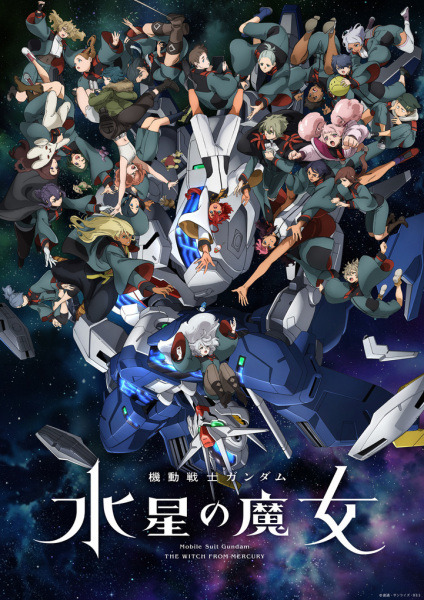
(Japanese title: Kidou Senshi Gundam: Suisei no Majo)
A Brief Summary
Humanity made it to space and set up colonies, leaving earth a bit worse off and struggling for resources. The colonies are run by companies (3 large ones making up most of the power) all under the umbrella of one man. One man with a daughter -Miorine Rembran - that is tired of being used as a political tool and wants to run away to earth.
Instead she’s stuck at a school where students learn to pilot and service mobile suits. At the school, Miorine is used as a prize where the top duelist is assigned as her fiancé - which would lead to a lot of political power after a marriage goes through. Everything gets turned upside down when a pilot from Mercury - Suletta Mercury - takes the crown at the academy. Suletta’s “mobile suit” looks a little different from everyone else’s. It looks a lot like a forbidden Gundam. This leads to a lot of corporate warfare that affects all of the colonies and Earth.
So, should you watch the anime?
Yes, especially if you enjoy mecha anime or Gundam in general.
Seeing 2D mecha in anime is always a nice treat. 3D can be fun, but I’m an older fan, and I will always appreciate 2D work more. The mobile suit and Gundam designs in Witch from Mercury are interesting, but none of them really struck my fancy. I blame this on Gundam Wing being my gateway Gundam - those designs were fire. I can only really remember what Suletta’s Gundam looks like when trying to picture the different designs in Witch from Mercury, but your mileage may vary on that depending on what kind of mobile suit designs you enjoy.
The plot-line/story likes to hint at bigger picture issues, with the adults playing at power grabs on a corporate level while the students play for power via the duel system at the school. This would be fine, but then, through the power of plot, the students at the school become a corporation that greatly affects the adult world. The fact they let kids handle such power is both admirable (let the kids learn how to work in the real world), but also dumb as hell (let the kids wreck the economy just because). I might have been happier if the kids stuck to the duels only, or if the duels were used more often in the corporate struggles. But it still kind of worked and was more coherent than some previous Gundam plots.
The Gundam franchise is going through a weird period where they are releasing very classic Gundam shows for the older hardcore fans (Unicorn/Hathaway), toyetic shows for the kids to buy merch (Build Divers), and some more experimental shows to try and get a new generation of audience into Gundam (IBO, and now Witch from Mercury).
It’s interesting that the newest shows in that final category both play with non-typical Gundam relationship dynamics. IBO had a focus on mostly male characters and even featured some (marginally) healthy polyamory. Witch from Mercury went the Utena route and decided on duels and a main female couple (even if the company won’t actually admit the canonicity of said couple). Good on Gundam for trying to widen their horizons for audience appeal.
Unfortunately for me, I didn’t like either of the main female characters. I will freely admit it’s my own personal taste, as others really enjoyed them (or so the internet would lead me to believe). But Suletta was a little too dumb, and Miorine was a little too tsundere for me to actually gel with them and care about their character arcs. The one exception to this is the final episode of the first arc (episode 12) - which I will not spoil - but sadly nothing cool came out of Suletta’s slight change of character after that moment.
On the plus side, there are other characters in the show - including:
A classic self-absorbed asshole who thinks he’s the best at first, but after a lot of hardship ends up becoming a changed and better man —and who also happens to be my favorite character in the entire show (Guel Jeterk).
A plot-spoiler-if-I-say-too-much student who sometimes acts cold and cruel, other times acts like a suave playboy, and all the times seems to get attached to the wrong women (Elan Ceres).
The “it’s Gundam so we need a character in a mask” mother of Suletta that is a little too smug and always seems to have the right answer…to help herself (Prospera Mercury).
A downtrodden Earther who is a genius mechanic, but somewhat of a doormat who has trouble standing up for herself (Nika Nanaura).
A young Earther with a few screws loose who goes from wanting to be Suletta’s cute little sister to wanting to kill people at the drop of a hat (Sophie Pulone).
A mercenary lady who has her fingers in a lot of information pies but seems willing to help Miorine out when she needs it (Jun Feng).
A childhood friend of Miorine who puts out a princely air and always seems to have a plan, which leads him to being generally calm and collected even when things don’t go his way (Shaddiq Zenelli).
Plus a whole heap more supporting characters that are tied to one house/faction or another. So even if you’re like me and don’t enjoy the main characters, there will be someone to like in Gundam: Witch from Mercury.
Where does it rate on my personal scale?
S: I will buy it at full price (unless it’s released by Aniplex USA, because fuck their pricing).
A: I will buy it on sale sometime down the line.
->B: I had fun watching it, but don’t need to own it.
C: It’s not my cup of tea, but wasn’t awful.
D: Dropped it.
X: Finished it out of spite, but did not enjoy it.
Mobile Suit Gundam: The Witch From Mercury ends up at a solid B. It wasn’t a show I eagerly looked forward to each week, but episodes did not fail to entertain me for 24 minutes at a time. I hear gunpla sales of the Mercury crew have been selling like hotcakes, so it looks like Gundam is hopefully back on track for a new generation of fans to keep watching and buying. I’ll keep sticking around too, though I don’t really feel the need to add G-Witch to my physical collection.
#anime#anime review#itsavgbltpta#should you watch the anime#witch from mercury#gundam#mobile suit gundam#g witch#gundam the witch from mercury
2 notes
·
View notes
Note
Can you please answer the fandom part of these asks for Magnificent Century? Yes, ALL of them.
1. the moment in the story that I started shipping my OTP from this world.
Soo I was literally a kid, but they had me from their first scene of Hürrem screaming Süleyman's name in the hallway
2. my three favorite characters and why I love them so much.
I have said this before, it's Hürrem, Süleyman and Ibo. I mostly just think they're the most interesting characters tbh, but I also love Nigar, Defne, Daye etc.. and Ibo can annoy me so it depends
3. which scene I would like to erase from the universe and why.
How do I choose just one.. hm maybe Sümbül stealing Gül's clothes😭 like that was soo stupid. I would say the entire s2a, but it says like one scene so..
4. why you should choose to check out the world of this story and choose three gifs that should underline my point.
Hmm it is genuinely fun to watch, characters are pretty well written, it's fun to binge once in a while. And yeah a lot of interesting female characters. About the gifs, I've no idea, but there's this Hürrem edit that I adore and everyone should check out
5. the scene from it that lives in my head rent free.
Hm it has a lot of good scenes.. some are cute, some are awful. I guess I'll do the basic Leo, Hürrem and Ibo's final scene. It is a pretty good scene, even though I don't think abt it that much😭
6. which is my favorite platonic or familial relationship in this world.
Daye and Nigar I think? But I also love s1 Nigar and Hürrem
7. How likely I am to follow the writers and directors from this project to their other ones and why.
Not very likely lol sorry mck
8. a quote from it that means a lot to me.
Oof .. I have no idea, there are some funny and some cringey and some actually nice quotes. Probably Hürrem's "Only in one case we wouldn't be enemies, only if you were my son." to Mustafa
9. Which characters I think should have interacted more in canon.
NIGAR AND SÜLEYMAN!!!!! Literally hidden soulmates not many will get it..
10. how many fics I've read that are set in it (approximately and making exaggerated guesstimates).
All your @faintingheroine and @minetteskvareninova 's fics, my beloved, talented pooks! Tho I still have to read one Ibo/S fic
11. what I think of the central character(s).
Umm are those central characters Ibo S and Hürrem, because I've already said what I think. But the rest, Mahi and Hatice I do like them, they have their moments where I really appreciate them as characters. You get used to them as well, but they can annoy me a lot
12. what attracted me into checking it out.
So there were literally these short commercials for this show on tv and I thought that it would be something stupid idjdjsj but then I watched the first episode because I was rlly curious and yeahh continued watching from there
13. Which canon or popular fanon relationship I can't stand or feel 'meh' about and why.
Ohh I have a few
Fanon-Ibrahim&Hürrem, I just don't see any romantic chemistry between them at all
F- Ibrahim&Süleyman, so I think their relationship works perfectly fine and is interesting as it is. Anything else would feel forced?
Canon- Ibo&Hatice, I don't hate their scenes, they are believable as a married couple, but I just don't see anything to really enjoy abt them and to ship here
14. If I think the largest majority of fics I crave for it are fix-its, nobody-dies-everybody-lives, fluffy fics of my OTP, pining fics for my OTP, or plot heavy Gen stories?
Not suree? I guess fix its? It has a lot of episode so it's not surprising. But tbh I also like reading just filler fics about it
15. which character I would choose for the chopping block if I knew the writers wanted to kill someone.
Fatma hatun 100000%
16. which character's death would (or did) make me rage-quit.
Hm so most of them died😭 idk honestly. If anything some characters should've died sooner. I guess I'm glad Gülnihal, Gül and Sümbül weren't killed off at least
17.the world-building aspect of the story I have the greatest admiration for.
I mean? I don't know it is supposed to be based on real history.. so not sure how to answer this one. They handled things aright, but it also could've been better lol. Okay I liked princes going to their own sanjaks, expanding the set a bit lol
18. the perfect number of books/seasons/movies needed to tell this story properly.
Hm I think 4 seasons is alright.
19. One behind-the-scenes trivia fact I've learned somewhere and my thoughts on it.
That big ass crown Süleyman wears is really heavy?
20. exactly how little or how much headspace this fandom takes up in my brain at any given point.
Probably too much, mostly because I see something related to it whenever I open this app😭
5 notes
·
View notes
Text
G witch Episode 3 was actually pretty good.
I don't like the school setting, and I probably wont ever think positively of it because the concept to me is not that novel. For people that think it's a good exploration of the politics or whatever, I'm willing to give them the benefit of the doubt for now.
I liked seeing the Aerial's weaknesses, and I liked seeing a foil character show more promise than the world (read: his father) gave him credit for.
I read the interview about how this is supposed to be gundam to be more approachable for teens since Gundam has a reputation for being for older men, and I can appreciate that a message conveyed through children is mostly lost if its audience is just old guys (even me, I am 26). Having this level of apprehension about new things is not "I want everything new to be the same thing that I know", if you're a fan of star wars, megaten or gundam you're used to new things being at risk of pretty uncharacteristic of what you expect from the series. (e.g. the sequels, smt4a, ibo...)
I don't know if this type of plot can clear some of my favourite series, but unlike IBO it has a writer I have faith in.
EP 1-2 were definitely super jarring to me, but people who watch it in the future will have the added benefit on not having the looming anxiety that it might be/or turn to, complete shit like IBO does after the first season. I liked that this episode focused on the aspirations of both a protagonist, and a foil, and that the battle signified not just their political stakes, but to the children it was about their dreams, while their parents' aspirations were hitching a ried with this battle. For that, I will say that Episode 3 had great writing, where I felt the first two episodes (post-prologue episode) were quite boring even though the themes/what they were going for were not lost on me.
5 notes
·
View notes
Text
“Ay, Pastilan!”

There was a time, it was christmas and I was in grade 10 that time as well. We normally go home to our province, which is located in Impasug-ong, Kibenton near Malay balay City. After we arrived, my cat was restless for he is not familiar with the place. It was his first time there. My father said that let the cat roam around so he will be familiar with the place and surroundings. So I let him roam around and get back inside because my mom called me to help her cook our dinner. After cooking, I immediately searched for my cat, I kept on calling his name and he didn’t answer for he normally responded when being called, he would meow back. But there’s no sign of his existence, even a small meow. One hour, two hours, and three hours have passed, still he didn’t show up. My mom called me to eat my dinner, devastated but needed some strength. That night, I have been crying a lot, I can not sleep well. I got up from bed and grabbed my flashlight. I kept on searching and was about to lose hope. I will just accept what will happen, if he will come back or not anymore. I already lost hope, why of all the time and place, you get to loose a beloved somewhere you are not familiar yourself with. I kept wondering what he might be doing or there maybe other cats, dogs or animals that may hurt him and may be abducted since he was cute and looked expensive (we always wanted to ask the vet what breed he was, never got the chance though until he grew up to be fine mingming).. Again, I cried until I fell asleep and when I woke up, I was startled by the noise of a cat outside in front of our door. “Pastilaaaaan! there you are, pastilan ah but I’m so happy you came backkkk! I almost gave up huhu, thought I would lose you forever”, I said to my cat.
Pastilan is a Filipino word that originally came from Cebu, a province of the Philippines located in Central Visayas Region. Mostly used by Cebuanos and with Bisaya or Visayan dialect and tone, often describing a situation or person. It’s literal translation in english is “Oh my gosh/ goodness!” Used as an expression to stress an emotion, there are four emotions stated below which are; 1.) Expression of great worry or grief. 2.) Expression of feigned surprise or concern, with a disdainful tone. 3.) Expression of pain and annoyance. Lastly, exclamation of how interesting something is. It has no exact word to translate in tagalog but most likely the same meaning as ‘Makulit’ and ‘Nakakagulat’, an expression word when you are annoyed and surprised. It is an exclamation of surprises. A simple reaction to qualify one’s surprise, a comment to express one’s reaction to something that you are not expecting. Often expressed in the matter of good or bad. The word ‘Pastilan’ is always connoted to be a bad expression or cursed word when in fact it actually is not. It is accused for being a cuss word. They or the Adults, our Uncles and Aunts misconcept the word and and might have fanatically used the word in expressing great disappointment ; “Pastilan ka!”, “Sus, pastilan!”.
Going through, there was a movie and entitled “Panaghoy sa Suba: The call of the river”. The story is set in Bohol, Central Visayas during World War II before, during, and immediately after, the Japanese Occupation of the Philippines.
Duroy (Cesar Montano) is a banca operator who falls in love with Iset (Juliana Palermo), the most bewitching girl in her village. Iset is an obedient child whose father and materialistic aunt hope that she will marry the American businessman who employs her and thereby achieve wealth and status. The resident American businessman, John Smith (played by Philip Anthony), is an abusive, rude and stingy landowner. He notices Iset's beauty but sees her as a potential mistress rather than a future wife. Islet loves Duroy but obeys her parents.
Ibô (Reiven Bulado), Duroy's brother, is also smitten with Iset. As Duroy adores his family and does not want to get in his brother's way, he stops courting Iset. Duroy is devoted to his family, his mother (Daria Ramirez), Ibô and his sister, Bikay (multi-awarded former child star Rebecca Lusterio). Heartbroken after her husband leaves for an American woman and ill, Duroy's mother dies when they run out of money to purchase her medicine. John Smith sees Ibo talking with Iset at the warehouse and shoots him on the spot. Duroy vows revenge.
When the Japanese invasion begins, many men of the village flee into the mountains to become guerillas. The women and children stay, along with an American priest. John Smith is drafted into the American army and leaves. The Japanese commander who arrives notices Iset but does not attack her as many Japanese military personnel did elsewhere in the Philippines during the war. With the Japanese now in power, Iset's aunt wants her to marry the officer.
Several years pass before Duroy and his men launch an attack against the Japanese garrison. The Japanese responded by killing the priest and taking hostages. In 1945, a group of Filipino and American troops arrived to help the Boholano guerrilla force defeat the Japanese troops. Duroy kills the Japanese commander after a long man-against-man battle.
John Smith (mockingly dubbed "White Balls" by Duroy and his friends) returns after the war expecting life to continue as it was before the Japanese invasion. Duroy attacks him but after beating Smith and thoroughly humiliating him tells Smith that he isn't worth killing him. Iset refuses John Smith's clumsy offer to renew their relationship and chooses Duroy.
A movie that reminiscent the Region’s dialect, culture and lifestyle. It was released in 2004, Cesar Montano a.k.a ‘Buboy’ decided to produce a movie in the Cebuano language and acted as the main character. Many netizens commented about the movie and one of his famous phrases that bisaya and non-bisaya people would totally not forget and would understand during the scenes were “Pastilan” goes from ‘darn’ to ‘oh boy’ and “Uy kalami!” becomes “How sweet” instead of “how tasty!”. Because of Cesar Montano together with his movie, the word “Pastilan” became more famous and it spread not just in Visayas, but in Mindanao as well. Having said that, we get to have a glimpse of how the word really is known and used way back, even to the Ancestors. Well, 16 years passed by nevertheless we often still hear this kind of expression.
There are a lot of expressions to be used and ‘Pastilan’ is one of them. True enough, when you are shocked or even pissed, you often tend to say the word. It is a reminder also that whenever some people will hear you saying this, they will think that you are disrespectful, foul-mouthed and even foul mannered. The word PASTILAN, as time passes by, people are now used to using this expression, like, if I/you are gonna say it out loud today, most of the people will misunderstand you.
As time passes by, the word ‘Pastilan’ is being passed to generations (bisaya people or even other places, inside the Philippines) as a curse/cuss word. We heard and still hear our forebears say this word (especially to us, bisaya people) and they will scold you for saying it where in fact, we just heard it from them. It became a common belief or idea among the people that the word pastilan is inadequate or not proper to use. For it is just an expression, you cannot expect to not say it unless you never heard it from your elders or to the environment around you. We are living in the 21st century, a modern generation, for technology is rising up so fast. Why not use this opportunity to discover new words, or words you have just recently heard, their differences and meaning.
But as my mom and ate always remind me and I come to believe that you should always have to be careful on what words you use. You can not take the fact that we are truthfully surrounded by a cloud of witnesses, judging us not just by our appearance but as to what words come out our mouth, judging our Parents or the person taught us our manners. As others would say, “Giunsa man ka ug padako (how are we brought)” that we get to act the way we do. Despite the history and true meaning of such expressions not just this, prevention is always better or being more careful, minding the things or words, instead of bad mouthing rather able that word would be more encouraging. I don’t really have anything against anyone or to the people using the word as a cuss, they have their own side of the story.
3 notes
·
View notes
Text
Gundam IBO Odds-n-Ends (1/2)
Being the first part of an essay commemorating all the interesting, odd, and just plain funny screenshots I saved on my rewatch of Gundam IBO. I offer it in the spirit of shared fandom, as interesting information for the consideration of fellow fanfic writers, or simply meta for those who enjoy reading such things.
I have split these photos into three major categories: Worldbuilding, Characterization, and Hilarity. The first category is the largest, and makes up this first post. It consists of pictures that illustrate aspects of the show’s setting, and is further subdivided into Locations, Society, and Language & Arts. If any of those sound interesting to you, hit the jump!
Worldbuilding:
Locations: Screenshots of the various locales of the series, both to point out interesting things about them, and, about as often, to highlight hilarious signs. We begin, as the show does, on Mars.
I think it’s very easy to think of Chryse as kind of a dirthole in the show. We so often see it from the perspective of people like Tekkadan—whose base is located outside the city—or Atra, who grew up in a very poor area. Obviously there are some nice places, like Kudelia’s home, and there is a kind of dusty, sunny appeal to even some of the poorer areas, with their colorful signs and graffiti, but by and large, up until we start seeing locations like Admoss Company, it doesn’t seem much like a major planetary hub.
I think that’s because we don’t get a lot of high-angle views.

Here is Chryse as established in the very last episode, free from Earth meddling and finally self-governing. We’re clearly in its more affluent downtown area, given the government building (bearing the flag of The Martian Union) in the middle of the picture. It’s possible that it looks worse up close, of course, but notice the broad walkways, and the light-to-the-point-of-being-nonexistent traffic. Notice the splashes of blue, green and red in the architecture. Notice all the trees, both lining the streets and blanketing the city in broad swathes that would seem to indicate an unusually large concentration of lush parks. In the far, far distance, you can just see the mountains that surround the city on all but its north side.
All the evidence we have suggests a pretty awful class divide on Mars, but man, Chryse’s downtown area is still really nice. Kudelia probably spends large amounts of her professional time in areas like this.

Here, you can see that we’re far closer to the outskirts—note the slopes climbing rapidly into mountains—and are definitely back in a poorer area of town. The ground is bare, and there are no trees. At least the streetlights all work! Kassapa Factory is located in an area much closer to this than the gorgeous downtown, to judge from the proximity of the mountains in that final shot of Yamagi in the epilogue.
Moving on out of the city entirely—I’m thinking to the north, assuming the geography of Chryse is roughly analgous to that of Chryse Planitia, the Martian plain it takes its name from—one would find the Sakura Farm and associated holdings. We’ll stop in there later, but in the meantime, I did want to include this picture.

Though it’s never referred to by name in-series, this is the actual orphanage Kudelia founded at Sakura Farm. The photo is one of several in Kudelia’s Admoss office showing her company holdings—there’s also a picture of the mines—and was presumably taken not long after the building was built, judging by the lack of the art that would eventually come to decorate all its exterior walls. Derma and Dante work here in the epilogue, but Atra lives on the farm as well, so one can assume Akatsuki is never lacking for other kids to play with.
We move now to Jupiter—or at least, one of the colonies orbiting Jupiter. Saisei, where McMurdo Barriston lives and reigns, is home to an extremely healthy little shopping district, and it is just full to the brim with interesting or hilarious storefronts. Lets look at some of them!
First off, Saisei is loaded with bars. Seriously, the one the boys stop in on their first visit, Pub Someday, is one in a string of at least three—it’s sandwiched between Public House (‘public house’ being the term that the word ‘pub’ actually derives from) and Pub Always. I think Naze probably recommended Pub Someday to them, and I think that largely because, left to their own devices, I’m sure they would have gone into Pub Always instead. Why?
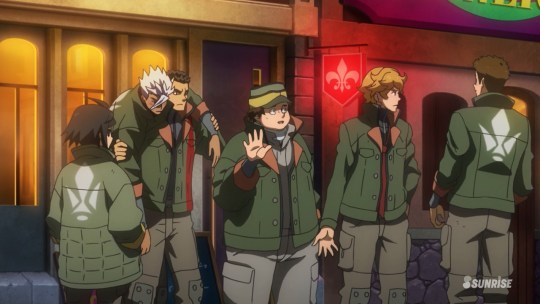
Note the neon red and white fleur-de-lis hanging on the side of the establishment (which they’re standing around in front of the entrance to because they’re a bunch of ill-mannered yokels). My god, how did they not go into this place? It has their logo just right there on it.
There are marginally less alcoholic portions of Saisei, however, like the one Lafter and Azee go do a touch of retail therapy in after Naze’s memorial service. They pass a store just called Delicious, but I think my favorite was HOUSE STORE, seen below.
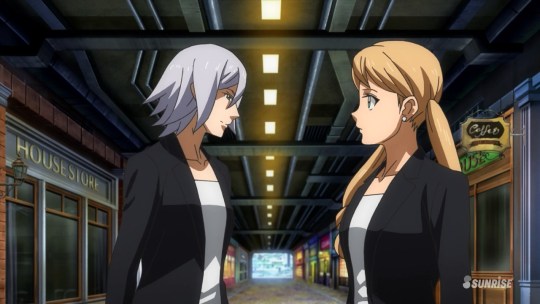
What does one buy at this store, I wonder? Furniture? Furnishings? Knick-knacks? Oh, perhaps it’s actually an office front, and this is where one comes to rent/purchase an apartment or other living quarters at Saisei?
Down the way from HOUSE STORE, of course, is the ill-fated Bear Factory. I want to look at the place next to it, though, because it has caused me some serious confusion.

So, the imagery here—the slightly frosted glass, the gold lettering, the delicate wrought-metal window decorations—suggests something like a high-end coffee shop, or perhaps some manner of light, ritzy soup-and-salad-type lunch café. If you run a Google search for “cocotaso,” however, the primary thing you’re going to get is something that does not at all match this building’s elegant exterior.
At least so far as the English-speaking world is concerned, “cocotaso” is a Hispanic-by-way-of-the-Caribbean slang term for when someone (often a parent) strikes you on the head with their knuckles; it’s usually in the context of a disciplinary hit, like a kid in the US might describe getting a ruler rapped on their knuckles, or “dekopin,” the forehead flicks you see in anime sometimes (in IBO itself, even—Naze drops one on Orga early on).
Now, I did manage to dig up another possibility, one that’s definitely the more likely reference, if by far the less popular Google result. “Coco” by itself is the Spanish word for “coconut,” and it’s possible to find some bottles labeled “cocotaso”/”cocotazo” advertising coconut water or coconut-infused brandy and the like—mostly by running the term through Image Search instead of a straight Web Search. I have no idea what the taso/tazo is indicating there, unless it’s just colloquial—particularly in the case of the booze, it’s no different than calling a drink a Screwdriver.
So, if I had to guess, I’d assume this lovely storefront is yet another bar, one of a vastly different cultural influence than we see in literally any other place in the show. I find it alternately hilarious and rather confounding.
Anyway, Saisei is really great to me, you guys. It’s like the space Mall of America except there are 1000% more bars and it’s run by the mob.
How about anything else around Jupiter, though? Saisei is literally all we ever see of the Jupiter Sphere, which is a bit disappointing when you’re wanting more worldbuilding. Well, I did spot one image that might be giving us a look at something else in that area. Specifically, in Naze and Amida’s flashback, we see them in a nice hotel room following a successful delivery, with Naze asking her to stay on with him more long-term. There’s a brief moment where the camera looks out the window, and gives us this vista:
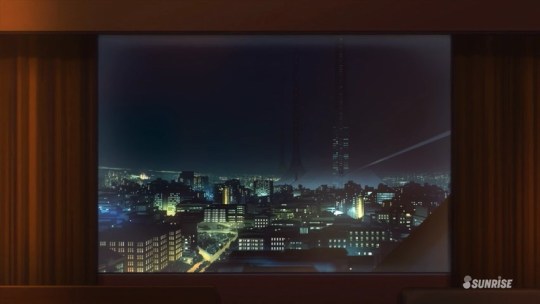
You can compare this to the scenes that take place outdoors on the Dort Colonies; the structures running down the center right of the picture are clearly of the same general design. A close analysis, though, suggests that it’s definitely not one of the Dorts we’re looking at here. For starters, they’re huge. Compare the 4-to-5-storey buildings on Dort to the huge office buildings here; they come up to about the same height relative to their respective pillars. There are also the lights up the center of the structures, suggesting some absurdly expensive offices or apartments available to rent—the pillars in Dort don’t have anything like that. Consider too the fact that in outdoors shots in the Dort Colonies, you could always see either the central pillar or the curve overhead of another part of the colony, often both. While it’s nighttime here, the way the whole town is lit up suggests that, if this colony were the same size as Dort, its sky should be full of “stars”—the lights from the buildings on the other side of the ring. But the sky is black and empty, without even a suggestion of the central pillar, much less the other side of the colony.
No, I’m inclined to think that this our only look at an actual colony in orbit around Jupiter—not an enormous ship like Saisei, which is technically classified as a “large planetary cruiser,” but an actual permanent colony. It’s one of the most metropolitan-looking places we ever see in the show, and certainly offers a fascinating glimpse of a place in the Jupiter Sphere unattached to Saisei.
One last look at a planetary location, in one of my favorite bits of accurate but poorly deployed English in the show. This shot is from Edmonton, during the Season One finale.
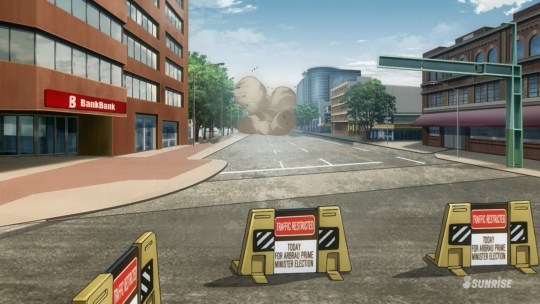
I direct your attention, not to the perfectly acceptable roadblock signs, but rather, the large bank on the left side of the road. You can tell it’s a bank because it’s been helpfully labeled as such. Twice, even, in case you missed it the first time. I mean, I guess you could say that this reflects the fact that Earth is divided up primarily by business interests. After all, normal banks are named after people, or regions, or types of trees, or major industries in the area—something sort of pleasantly descriptive of their history or business aims. But as Earth is run by divisions literally called ‘economic blocs’, you certainly can’t get much more descriptive than BankBank.
Meanwhile, out in the vast reaches of space…
Possibly this was obvious to everyone but me, but in the interest of sharing the information with people who share my lack of experience with a) sci-fi and b) mechanical thinking, I offer a pair of pictures of the bridge of Rustal’s ship, Arianrhod’s flagship vessel.

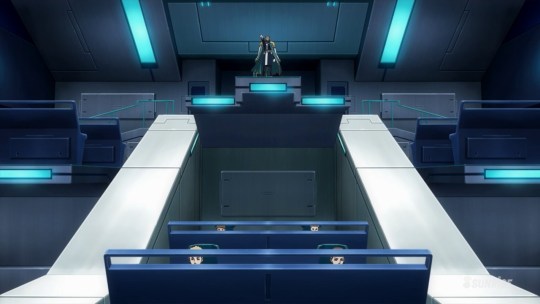
Like, compare those working areas, that raised, rear bridge area to the same layout on the Isaribi. I’m pretty sure just half of that back area would fit Tekkadan’s whole bridge. Tekkadan’s bridge has five positions counting the captain’s seat—the halfbeak here seats—what, like thirteen? Cripes.
Speaking of things that are way bigger than I had initially assumed, my last photo for this section is of one of the Ariadne beacons.

That tiny little lifted bit crowning the Isaribi is, of course, its bridge, where Orga and company hang out all day on their space travels. Compare it to the beacon in the background. I had no idea the Ariadne beacons were so huge until I went looking for a picture of one. I’m pretty sure just the lighting array on that thing is taller than a grown man, and that’s with the beacon still fairly well in the background of the shot. I have no idea why anyone might need this knowledge to write fic with, but I did think it was interesting, so there you have it.
Society: Pictures of stuff in the world, things that illustrate local color, shadows of unnamed organizations, bits of home furnishings, and other such things that influence what you might loosely call the setting’s ‘lifestyle’. As before, lets start on Mars.
One of the things we see, if I recall, fairly early on with Atra is that she knows how to drive. This crops up periodically throughout the series, with probably its best showing in the season one finale, but my favorite scene of Atra driving is probably in the first episode of season two. Why? Well, because in season two she has her own car—and you can tell its hers by the vanity plate.
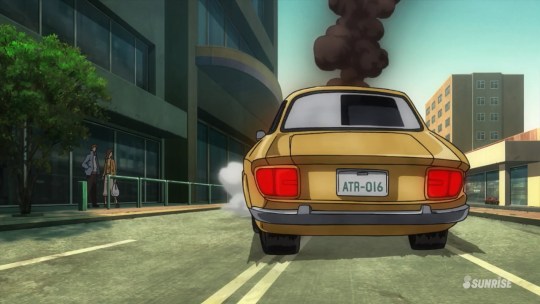
“ATR” for Atra, “16” for the year (most of) the show aired in, see? I’d also peg the 016 as indicating Atra’s age at the time she did the paperwork for the vehicle registration. Kudelia is sixteen when we first meet her (per Gjallarhorn’s info), and Atra being two years younger than her feels about right. This would also make Atra sixteen or seventeen when she and Mikazuki make a baby together, which is in line with Japan’s prefectural laws regarding the age of consent.
The vanity plate lettering aside, this does also tell us that cars need to be registered with someone in this world, which further implies the existence of a Martian DMV, which is just delightfully terrible.
It’s probably so terrible that when people get done, they really feel they need a drink. Well, luckily the setting has loads to offer on that front. Consider the following:
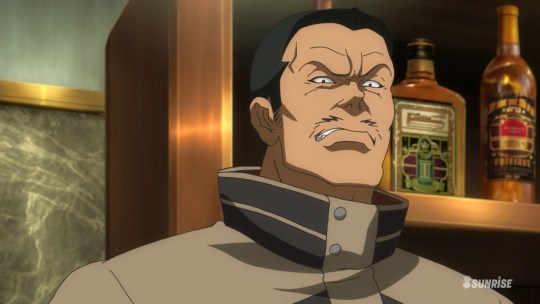
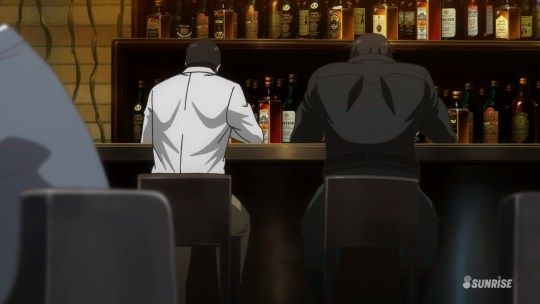
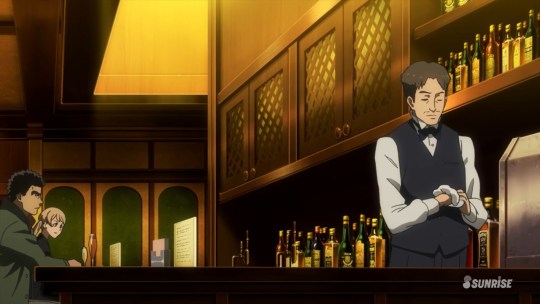
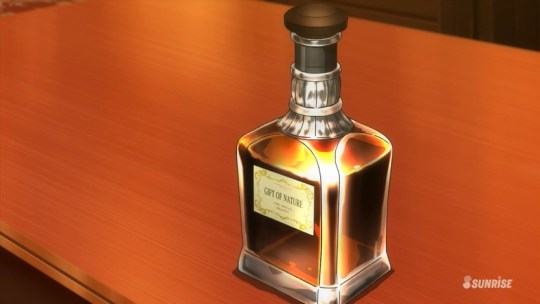
(What do you suppose happened to all the booze in Maruba’s office? I’m inclined to think Orga didn’t have time to do much with it just after the coup, and by the time he got back, he’d had the experience of getting trashed at Pub Someday and decided to cultivate less vomit-inducing vices.)
So, one thing to note is that, at the official bars in the setting, you tend to see a pretty high amount of repeat bottles, especially at that Earth-side bar Galan and Radice are meeting at. I’m altogether certain that the meta reason for this is just duplicated resources—setting designers have only got so much time to slap together alcohol label designs—but it is a little interesting to contemplate in-universe reasons. If so much of Earth was destroyed, how much is really suitable for cultivating the sorts of plants you need for alcohol? Is vineyard destruction why so few of these bottles look like wine instead of amber liquors like bourbon, brandy, and rum?
Moreover, is Pub Someday considered to be a “fancy” place (per Lafter) because it has Earth booze? Note that you can see some label overlap between the first and third pictures if you look closely, whereas the stuff in Maruba’s office doesn’t match anything else. Do they manufacture alcohol on Mars? Are there any local specialties? Is import and export very restricted?
The “Gift of Nature” there is, if I’m reading the label right, a brandy—though a cheap one, according to Amida. It’s Naze’s favorite, the one he and Amida drank at their first meeting (though the label on that bottle looked different—perhaps a redesign has happened in the, what, 10+ years it’s probably been since then?). From an American perspective, this is pretty amusing to me—brandy is one of those drinks with a very posh, moneyed kind of image about it. That Naze buys Amida cheap brandy—a poor man’s rich man’s drink—really just says everything about where he was in his life at the time.
But talking of money: I mentioned this some time ago in one my Human Debris Masterpost installments, and at least one fic I wrote for Yuletide last year, but: we do actually have a canonical shot of what denomination this setting’s money comes in.

Two possibilities here. The obvious one, phonetically, is that the money in this setting is literally named after its biggest police force, Gjallarhorn. This is both funny and deeply depressing, but either way, illustrates Gjallarhorn’s power in the setting. It even makes a certain amount of sense, if Gjallarhorn is nominally there to arbitrate between the economic blocs—you would want a common currency, and wouldn’t want it to be too tied to any one bloc.
There’s also a Norse myth that’s relevant, though, and given how accurately the Vidar reference was deployed, it’s worth looking at what ‘galar’ could indicate in that context.
Fjalar and Galar were dwarf brothers, distinctly murderous ones, and their main claim to fame is the murder of a supernaturally wise man, Kvasir, and use of his blood to create the mead of poetry, which grants wisdom, knowledge and creative inspiration. Using Galar as a name for money is an ugly little metaphor, I think, and one I could certainly see some very smug—or deeply jaded—scholar coming up with. Money buys all manner of things, of course; artists can have patrons, put money in, get art out. But because the denomination isn’t named for the source of the inspiration, the murdered man, but rather one of his murderers, there’s an undercurrent of violence, a suggestion of blood money. No matter what you want, throw enough money (violence) at it, and results will blossom beautifully. Guys, I’m pretty sure whoever named this setting’s money lost his entire family in the Calamity War, or something equally morbid.
As to its value, I think one galar is probably far closer to one yen than one dollar. Why? Well, while I can’t remember where I pulled this shot from (Atra’s flashback to meeting Mikazuki, maybe?) we do see bills in this exact same denomination in one other place in the series—the cairn for Tekkadan’s dead after the fight with the Brewers. So, yes, I think the bits of money that a bunch of underpaid orphans were able to scrounge up out of their pockets to literally shoot into space are likely to be very low value indeed. I imagine most major transactions are just handled electronically.
One other thing: I think this is the back of the bill. If you compare it to the reverse-side of the same denomination, the other side has the more elaborate design, the more visible numeral, and higher general visual clarity. It also has a big old picture of the African continent on it—perhaps other denominations also feature geographic regions? On the reverse side, meanwhile, are an indiscriminate blur of what I think are meant to be people, presumably some manner of historic group or another.
While we’re talking about emblems and the setting’s peace-keepers, I want to point out something I noticed in the epilogue—I think Rustal’s done away with the Seven Stars logo? Like, it’s still on all the flags at Vingolf, but there’s a new one on the Reginlaze standing behind him when we first see him in the epilogue and find out he’s become the new head of Gjallarhorn.

On the old emblem, six stars surround the central star; on this new one, the top and bottom stars have been removed. I wouldn’t think it was to honor the fallen members—the Seven Stars as a governing body were retired, first of all, so they shouldn’t be on the logo at all anymore. More to the point, though, the group lost three families, not two—Issue, Kujan, and Fareed. Perhaps the new arrangement is a reference to the four economic blocs, with the cental star now representing Gjallarhorn itself?
Still talking about emblems, here’s a screenshot from way early in the show:

So, as far as I can tell, this is the emblem of Gjallarhorn’s medical branch—you can see the same uniform on the doctor getting yelled at by Gaelio about Ein’s prognosis, later on. And that’s all well enough as it is—I wonder what the logo is meant to represent, in an organization so built around Norse mythos?—but we do see it in one other, somewhat more interesting place as well.

First-aid kits! So I guess we can assume the logo fills in the place of our world’s red cross. Of course, in our world the red cross is a legally-recognized emblem that can be misused or misapplied, in use the world over (with different variations in use in other countries, most prominently the red crescent), not bound to any particular government. Unsurprisingly for the Iron-Blooded Orphans world, their red cross is affiliated primarily with Gjallarhorn—no different than their money, I suppose. I wonder, very much, if the economic blocs have tried to keep their own currencies and the like that struggle to remain valid under the supremacy of Gjallarhorn?
But, enough about institutions! Who wants to look at home furnishings??
Specifically, the furnishings in what I’m assuming is the Fareed apartment on Vingolf, as we see McGillis and Almiria here repeatedly in season two, and it’s the place where Almiria stands her ground as McGillis’s wife against Gallus coming to take her back home. It’s an interesting mix of fairly standard looking furnishings—nothing too futuristic or archaic, just a modern-looking space, airy and warm, if perhaps with one too many chairs in it. There are only two things in it that stand out to me on a technological level.
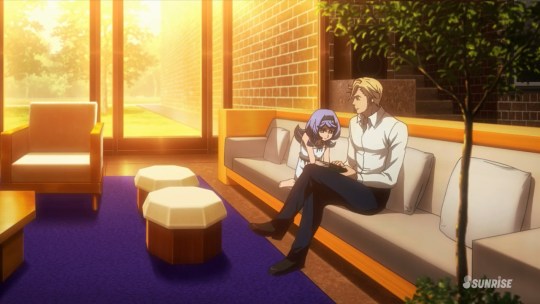
While I’m pretty curious about where those stairs hiding behind the potted tree go, given the stretch of building visible outside the sliding doors, what really caught my eye here was the speaker system tucked against the bricks, above McGillis’s head. It looks like such a perfectly real-world device, so much so that I wonder if it’s some kind of antique, or built to resemble one. I’m pretty certain we never see anything else like it in the show, and it makes me wonder about the role music has in this setting, especially recorded music.
Is it a thing for the very rich only? Are there Martian radio stations? Are there subtle variations between the genres of music popular around Jupiter’s moons? What about live music? Does anyone busk on the streets with hand-me-down musical instruments? How much would the Seven Stars pay for live entertainment at one of their important parties? Are there still famous musicians that hold blow-out concerts on Earth? How much cultural exchange is there between the planets and colonies in the system where their music is concerned?
Moreover, what kind of do you suppose McGillis likes? Myself, I’d guess big Wagnerian operas with convoluted plots and a lot of tragic-yet-noble bloodshed. I feel like it’d appeal to the same moral binary in him that the Gundams do.
The other thing in this space that caught my eye is the fireplace. What’s that? You don’t remember there being a fireplace? Well, that’s because…
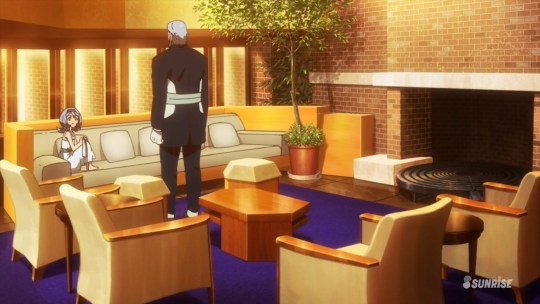
This—this can’t be very safe, can it? I mean, it’s basically one enormous heating coil, like someone super-sized an electric stove and plopped one of the heating elements down in their living room. But, again, it’s huge. I have no doubt it can heat that whole room; what I question is the idea that any of that furniture wouldn’t be much too close for comfort. To say nothing of the carpet!
Also, if you’re not going to have actual open, dancing flames (or at least an image thereof), why bother with the huge recessed space for it? And does that space lead to a chimney? Is this just the world’s most bizarre space heater design? I am just—so totally baffled by this thing.
Lets look at someone else’s living space.
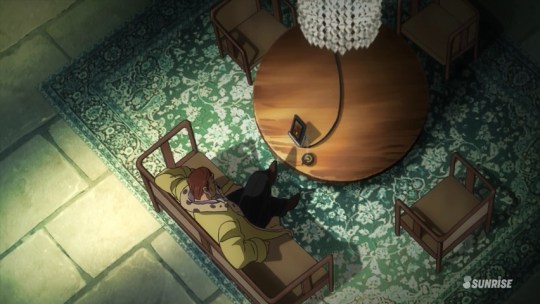
I saved this first with the thought, “Man alive those are some huge bricks; where did he even get them?” I have since realized that, duh, they’re certainly stone tiles, not huge bricks, but still, they are pretty ginormous, and lend a chilly, austere severity to Jasley’s room. Most of the wealthy seem to prefer warmer spaces; McMurdo Barriston and Nobliss Gordon’s offices are all wood and warm brown shades (even though Gordon likes to sit around in the dark), maybe accented with cool furnishings here and there. Likewise McGillis’s apartment, above; the enormous purple rug in the middle of it is the one cool touch in a mostly neutral-warm palate.
This certainly contrasts Jasley, who is, I’m pretty sure, one of the financial moguls of Jupiter—he heads J.P. Trust, which sounds very much like a bank name to me, and we know finance is one of Teiwaz’s corporate activities. Does he just has unusually spare tastes for a rich man in the setting? That seems unlikely, given his loud coat and paisley-decorated battleship. Or is the loud stuff for a public face, while privately he prefers the more stark sensibility? (Of course, it’s also possible that it’s mostly a meta choice, to remove any warmth from around the character, as he’s not a man the audience is meant to feel warmly towards. But I always want to look for the in-universe reason first, for a project like this.)
Also, Jasley, you’re so rich. Get some more comfortable furniture for you and your goons to sit on, jeez.
Lastly, to stay with Jupiter for a moment longer, I offer some flowers.
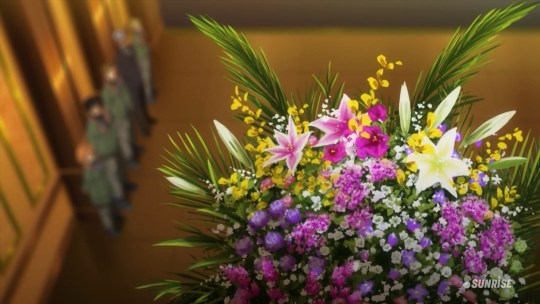
This is the arrangement Jasley sent to Naze’s memorial service. I wondered for a bit where these come from—imported, for maximum braying display of wealth and power? Local, because trying to transport fresh flowers across the expanse of space sounds like an enormous pain in the ass when you could just build a greenhouse locally? It seems to me that these are probably local—local to Saisei, even. All the other flower arrangements in this scene look like they contain mostly the same sorts of flowers, just in far more modest numbers. That suggests to me that there’s probably a florist in Saisei’s shopping district who occasionally gets ludicrous amounts of money from some mafioso or another who wants to swagger a bit at a rival’s memorial. What a life, eh?
Lets look at a little more ‘in-the-life’ stuff for the setting.
Language & Arts: A short section on, as it says, language and arts.
So, while of course the series is voiced all in Japanese, overwhelmingly, the written language of the setting is English. The signs, text from Gjallarhorn/Ariadne databases, newsfeed scrolls—all of it is in English. Given the cultural mishmash the Earth and its outer orbit colonies have become—look no further than Mikazuki Augus sitting alongside Biscuit Griffon!—I’m inclined to think English is just the language that survived as the dominant written text, and is probably the language everyone is “actually” speaking (see Translation Convention). There are a few places where others crop up, though! They are in exactly the places you’d expect.
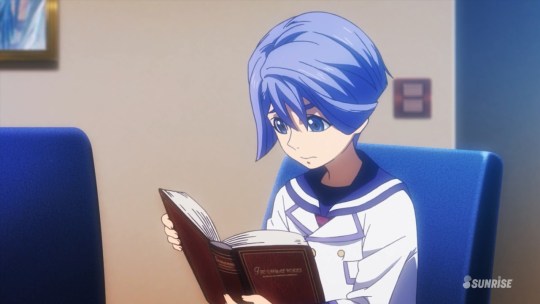
I can’t make out the full title on the book kidlet!Gaelio has here, but I do see “Im” and “Wald,” so it’s “In the ____ Forest” in German. I can’t imagine the organizations’ members on the whole speak the language—we see English on all their screens—but it’s not at all surprising that the leaders of the organization would have some exposure to it, though German is not, itself, a linguistic descendant of Old Norse. (Of course, if associating Norse myth with the German language is as close as IBO ever gets to the UC’s fascination with Nazi stand-ins, we should all count our blessings.)
The other language in the show is the more obvious one—Teiwaz is the place in the show where the yakuza/mafia trappings dwell most openly. The first time we see Japanese in the show is in their brotherhood ceremony, and they are where it crops up most regularly. There are a few places I’d like to mention specifically, though.
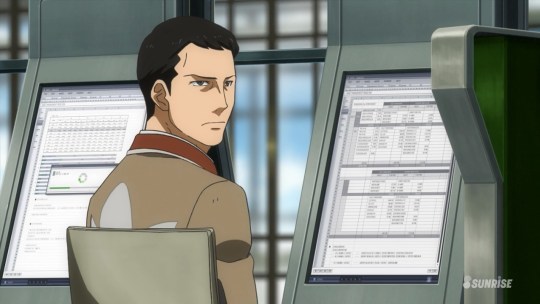
So, that thing I mentioned earlier, where I said the language on screens was always English? This is the only exception, and it’s really cleverly deployed. Teiwaz may or may not conduct all their internal business in Japanese—their ceremonies use it, but English is still the dominant written language in Saisei—but Radice uses the language for all his accounting. We know that, not only did Radice betray Tekkadan to Galan Mossa, he had also been engaged in the more mundane crime of embezzlement, and who would ever have caught him at it? No one in Tekkadan reads the language, even if they did understand accounting well enough to follow his tracks—Merribit was, I suspect, the only person in the organization who had even a chance of figuring it out, and she was on Mars. Radice is a rat bastard, but not an un-clever one.
The other places we see the language in the show are unconnected to Teiwaz, save perhaps through discreet family alliances. We see Iok practicing some calligraphy during his mid-season “exile,” and we know he has a longstanding family connection with Teiwaz, so him playing around with the language is eyebrow-raising, but not all that shocking.
The other place is a little weirder, though.

Okay, so, Makanai Togonosuke—that is a seriously Japanese name. I think he’s actually the only example in the show of someone who has a Japanese family and personal name. He was the Prime Minister of the economic bloc that had its capital in Edmonton, Canada, but that’s not so strange—the economic blocs encompass huge, improbably strata of geography, after all. The weird thing is that Arbrau isn’t the economic bloc that actually includes Japan—Japan is in the Oceanian Federation. Arbrau has all of Russia, which certainly gets it very close to Japan, but it does make me very curious about Makanai’s early history.
Did his parents emigrate? They must have stayed fairly connected to their Japanese heritage—despite being a leader of Arbrau, Makanai never lost his grip on Japanese culture. It’s not just his name, but his clothes and his housing, too. Of course, his island exile might have been around Japan; if he maintained strong ties to the country, and remained fond of it, why not live there while in exile? This would certainly match with having to travel over water to land in Anchorage. Perhaps this strong connection factors into whatever scandal it was that got him ousted in the first place?
In any case, it seems Japanese culture certainly survived the Calamity War and on into the future, where we can still find calligraphy practiced as an art, and bonsai trees tended as a hobby.
What about more traditional art? Well, certainly you can find examples of paintings all over the show, in offices and halls and homes. I wanted to turn my eyes to two specific examples of things we see framed in the show. The first is not a painting, but actually a photograph.
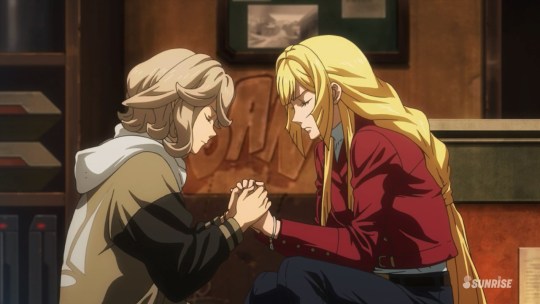
Specifically, it’s a black and white photo (maybe two of them) hanging up in the store where Atra worked at the beginning of the season. Now, a black and white photo hanging in a store wouldn’t seem so strange in a modern setting—it’s the town founding! Or the store opening! Or just some generic decoration!—but it does seem pretty weird in a futuristic setting long, long after the development of color photography! We know color photography still exists—the show’s last ending sequence is a slow pan-out from an in-universe photo, after all—so what possible reason could there be for the set of black and white photos here? People work in monochrome for artistic reasons sometimes, but this photo is just a bunch of buildings—it really does look like a “founding of the town” kind of photo, save that, again, this is a far-future sci-fi setting that has no reason to have been limited to black and white photography any time within the last, what, four to five hundred years?
Suffice to say, I find it pretty bizarre.
On the topic of pictures of places from long ago, though, what does everyone make of the painting on the left here?

Specifically, what are those spires on the left side? They don’t look like any kind of object I can make out, nor any sort of architecture with which I’m familiar. They’re not ship masts, nor do they match up with Gjallarhorn’s HQ ship-island, Vingolf. I sort of like the idea that we’re looking at some kind of very early spaceport facility, though the geography on the right side is a little prominent to be landing a big shuttle on. It almost has to be some kind of old Earth structure, though, given the painting’s location in the private home of a member of the Seven Stars.
Lastly, I wanted to showcase something that I wish I saw paid a bit more attention to in all the post-series Ride drama—the young man’s artistic streak. I can’t prove he’s responsible for every one of the works below, but it does seem in line with what we know he did—the Tekkadan logo, which Orga asked him for, and no small portion of the Isaribi’s interior graffiti, which we can see him working on in the second closer. He has an eye for fun shapes and mural work, and if he’s responsible for all or even most of the paintings we see around Tekkadan and Tekkadan-adjacent properties, art clearly consumed a huge portion of his time. Of course, for all the hugely colorful work on e.g. the orphanage, we don’t see Ride doing anything artistic in the second season. In retrospect, I wonder if this is some early foreshadowing of the darker path he’s headed down—that he puts down the paintbrush to focus on mobile suit training instead.
In any case, here are a few screenshots of, presumably, his stuff that caught my eye.
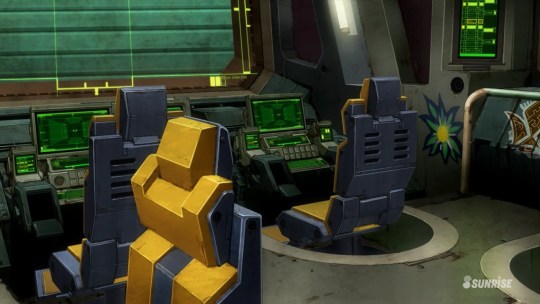
It’s a little thing, but the sunburst here is pretty, its curves and use of color somewhat more delicate than a lot of Ride’s stuff. A lot of his stuff is big and bold, using large amounts of red, orange and gold—this is softer than that, though it still speaks to a certain brightness of image and hope. It even kind of matches the bridge’s color palate!
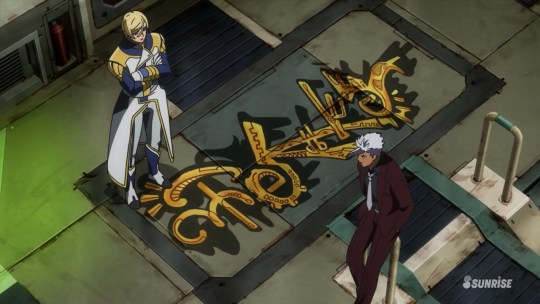
This, on the other hand, is much more in keeping with his usual stuff. It also confounds me, in that it certainly looks like calligraphy, but I can’t make heads or tails of any Japanese characters that might be hiding in there, and it certainly isn’t using the English alphabet. I’d dearly love to know what, if anything, it’s saying, though. If it isn’t a rendition of any particular writing system, I wonder if it was inspired by Teiwaz’s big brotherhood ceremony banners? Ride wasn’t at that particular ceremony, but enough people were whom Ride might have pestered for details about what it was like that I could see him hearing about it—and that’s assuming he didn’t just see some around Saisei or the Turbines ship at some point between Tekkadan’s first joining up with Teiwaz and McGillis and Orga standing around having this conversation. If that is the source of the inspiration, I wonder what Ride was trying to communicate with this? What words he thought he was writing?

Lastly, I turn an eye to this fountain of feathers. This is the least likely to be Ride’s work of the three, especially if it’s chalk instead of paint, but if it is his, I wonder where his mind was at when he drew it? Wings, for freedom? Feathers, for angels, for death and/or the afterlife? It’s a piece that looks perpetually unfinished, or perhaps restless—I like to imagine it is his work, but it’s from after Orga and Mikazuki’s deaths, but before Ride has cut ties with his old gang, when he’s still wrestling with what to do and, perhaps, still waiting on the older boys to come up with a plan he can stomach the idea of.
And with that bit of shameless speculation, I draw this portion of the essay to a close.
The second half of this essay will contain the other two categories mentioned at the start: Characterization and HIlarity. The second category will consists of pictures that illuminate or provoke questions about the show’s characters. The final category contains pictures I just thought were funny and wanted to highlight. If you got through this whole post and still want more, keep an eye out!
#mobile suit gundam: iron-blooded orphans#gundam ibo#g tekketsu#atra mixtra#ride mass#togonosuke makanai#teiwaz#gjallarhorn#worldbuilding#my writing#ibo meta
18 notes
·
View notes
Text
Slovakian Brides
Thus, developing a profile about such a site does not inspire hope. Without a doubt, hundreds of online dating sites websites and various all mail order bride-to-be services own filled the web, so that it is available for men from throughout the globe to get connected to foreign brides to be.
What Makes Young girls From Slovak republic The Best Birdes-to-be?
Slovakia might not be the most popular holiday destination in Europe because of the humble sizes of the region and a great underdeveloped entertainment sphere when compared with its neighbors. No agonizing failures and heartache. Concur, it is upsetting to hear what sort of pretty stranger sends you to the distant empire when you are practically ready to call and make an offer to her. Only those people are signed up on our online dating service plan who wonderful willing to meet and so are set up for a severe relationship.
Attractive try article writer. But not almost all what you write applies to the modern world. I agree considering the idea that most who remaining Nigeria illegitimately are looking for a way to be legal by getting married to any kind of female that comes their approach just to get a residence for the country yet don’t forget that a few of this person are mainly university graduate and would would like to work lawfully in the country likewise in the event give the prospect.
i connected with this Nigerian almost this past year when he came to my region as a you are not selected researcher. He came in Jan 2014 and was presume to keep in May of the same year. However , he overstayed and underplaying the extend to which he overstayed. He has said to get married to him although my single hadn’t recently been finalized confirmed. He provides meet members of my loved ones but this individual felt timid to speak professionally with my dad. Is this a negative sign? i’ve spoken together with his parents but they how to start that my personal divorce isn’t final. His father has got asked him about me personally but he hasn’t informed him the extend of our relationship.
Ibos are no doubt the center and excellent movers of this Nigerian financial system. They are ground breaking, creative, committed, peaceful, etc, but they love financial success more than anything else in life. You are able to play with an Ibo man’s your life, but is not going to play with his money! Hence when coping with an Ibo man, be sure to don’t get his finances; therefore , if you guard his wallet with regards to him, you can expect to always be his best friend. And this love designed for financial contemporary is one of the things that make these people very innovative and ambitious in no matter what they do anytime. Note this, any store, business, and so forth owned by a Nigerian in your country, go and find out, it is owned or founded simply by an Ibo man. These assertion is not just applicable in foreign nations alone, nevertheless also in Nigeria.
Slovakian singles happen to be that uncommon case where intelligence and beauty think together in a single body. They are really of a typical Slavic appearance, which has get a standard of beauty. The majority of are cute blondies using a delicate nose area and higher lips staying fuller compared to the lower. In addition, psychologists understand it saying such women are extremely giving and put others’ requirements above all.
The girl is a riddle, they say. Gowns definitely regarding Slovakian. From your first sight, you’ll think she is a relaxed, modest, and trusting little girl. Although don’t get that wrong! After having a few dates, she’ll gradually show you her inner passionate, sensual tigress. These women find out perfectly tips on how to intrigue the man and generate his fire burn.
Unfortunately, most of the previously mentioned class of Nigerians would rather prefer to come back residence and look for a wife, you understand why? Because our social and classic values will vary, stronger and as such, supports matrimony better. For instance, when a standard Nigerian couple is going through marital entrée, they would rarely throw in the hand towel like it is usually done in the western countries. Remember, relationship in Nigeria is a union of two families- the man’s and the woman’s relatives, and as such the families might step in if perhaps things are getting out of hand they usually would perform whatever they will to settle the situation amicably inside the family level. Nigerians generally, have undeniable respect with regard to their parents and would hear and comply with them at any time in time.
I actually am a Nigerian Guy and most of what you say holds true, apart from the partying of the Yoruba man. Igbo’s and Yoruba’s adore to party since its similar to going to the films or golf clubs. the social gatherings are generally during festive occasions, sites to be or marriage ceremonies. However folks are different in disposition and countenance thus generalizing based upon tribe is normally flowed. We detest persons, believe in family members, love and faithfulness which include my religious beliefs.
Therefore , the the majority of viable choice to meet Slovakian women for marriage is by using a Slovakian submit order star of the event site. These sites make it possible for foreign people to get in contact with the Slovakian brides of their choice with no stress. You can work with a translator as well as other dependable professionals in order to meet the Slovakian girl of your dreams.
Join
Making fresh relationships after a failed marriage is always challenging. They want to live a better life. Since Slovakia is not really among the abundant European countries, local women may wish to change their very own place of living to some Traditional western state. Often , the easiest way to do that may be to marry the resident of one other country and move in to have together.
Building agencies happen to be crawling around Slovakia looking for girls for manner brands. Slovakian girls include slender styles and noticable cheekbones. Slovakia girls always maintain balanced and healthy diet and way of life. Also, the height makes them perfect candidates for building agencies. Fitness center culture in Slovakia is very popular. You happen to be unlikely to discover a Slovakian girl that is away of condition.
I run a corporate organization and because of ridiculous thoughts like this my own HR employees do not take a look at nigerian applicants more than once because they suppose everything about that resume is a lie no matter the encounter. So genuine people seeking to make a life find it hard. You really don’t understand the ripple effect of this information. Western girls are not stupid mainly because u think some just choose to do stupid things when they can see benefits signs m guy is mostly a looser and a no person. Someone going out with an illegal immigrant realizes he is one particular but yet choses to continue.
What am I looking to say in essence? An Ibo man often carry at heart his money or profit in whatever issue this individual does in life- be it business, education, relationship, and so forth It is this kind of trait that earned Ibos criticisms from other Nigerian tribes, because in whatever they may be doing, they can be always conscious of what they would gain fiscally. To spa it up, Ibo man is just similar to a Oriental man in terms of- funds consciousness, creative imagination, and design.
You will be thankful for their speedy wit and comprehensible design which is rare to find. Slovakian women are very mature. They will willfully understand your goals from the marriage. With their stiff life concepts, they will adjust with everything to save the relationship. This roots to their childhood which educated them to become respectful in any marriage they build. With her down to earth persona, a Slovakian woman may ultimately end up being the messiah of your life.
Slovak women will be conservative because they grew up in a mostly Catholic region. No, it doesn’t mean that all Slovakian ladies are religious, but they usually take dating significantly. They are more likely to look for determined relationships, therefore you need to esteem them to that.
10 Reasons Why You Should Say Dating These people
Making fresh relationships after having a failed marital life is always difficult. Secondly, each important decision of a family group has been to be only when using the agreement of two sides. Brides cannot put up with the fact that no one conferred with them. Matrimony makes two halves together. They cannot separate you” and I”, combining that into we”.
Don’t weary her with political comedies. 40 years aged Slovakian female might nonetheless hold this sort of a chat, although young ladies will have nothing to say. That’s not mainly because they understand nothing with this field and so are stupid. They will just typically think it’s an appropriate topic to discuss. Talk about cinema, traveling, music, and mindset instead.
Quit spreading hatred rather channel your publishing skills to providing ethnical specifics in the various nationalities and what to expect. I stumbled with this and revealed it to my hubby, he laughed and said all you could just had written is applicable to uneducated, uninformed families. Educated well meaning Nigerian men are to choose from which can give you a happy life.
After taking garbage from some black males in these western world because of there inferiority complex. All of us black women of all ages are now taking crap from our own dark-colored brothers home because of ” foreign women ” will you be kidding me? These are they same black girls that carried these dark-colored men designed for 9 weeks in there tummy and yet what we should are getting is definitely, our Nigerian brother having us because second option in marriage. This really is madness, really.
Learn about her culture. Slovakia has an affluent cultural customs. There are a lot of historic sites you can travel to, especially through the https://bestrealdatingsites.com/slavic-brides/slovakian-brides/ countrywide holidays. As well, you should try to know the language. It is rather difficult, but learning the basics is going to put a smile on your Slovakian bride’s confront.
There will be simply no barrier in communication as most within the Slovakian women are very progressive in British. With their top quality of education, they have superb command over the English terminology. You don’t have to stress about her without any wit in terms of connection. As most of the women feature their college degrees, she will have the brains to impress you as well. You will not run out of topics to discuss, and that’s an essential part of every single relationship. Furthermore, you will be pleased to know that your wife is designed for any kind of discussion.
Bài viết Slovakian Brides đã xuất hiện đầu tiên vào ngày Máy lọc nước Plasma - Máy lọc nước RO Nano Chính Hãng.
from WordPress https://ift.tt/37H9mJu
via IFTTT
0 notes
Text
Reimagining Old Friends at the National Theater in London
LONDON — Shall we all speed-read together? I mean, as in consume hundreds and hundreds of pages as fast as the human eye permits.
We’ll let our attention alight briefly on names of characters, central plot points and major thematic statements, via a text that has been helpfully illuminated with neon marker. And all those pesky auxiliary words used to summon nuance and detail will runtogetherlikethis into an inky cloud.
Such is the experience of watching “My Brilliant Friend,” the breathlessly paced, two-part stage interpretation of Elena Ferrante’s “Neapolitan Novels” at the National Theater. Adapted by April De Angelis and directed by Melly Still, this production compresses the acclaimed four-volume portrait of two women who come of age in mid-20th-century Naples into less than five hours of galloping onstage synopsis.
Though I haven’t seen any of the Italian television version shown on HBO (eight episodes so far, with a projected 24 more to come), I eagerly devoured each of Ferrante’s books as soon as they were published in English, so I was generally able to follow what was going on in De Angelis’s version.
But heaven help the innocent theatergoer who meets Ferrante’s characters for the first time in this production by the National Theater and the Rose Theater Kingston. After watching both parts of the show in successive performances, I saw fellow audience members stumbling out with glazed eyes and what-was-that-all-about expressions. “Well, it might make a good movie,” I heard one of them say to another.
“My Brilliant Friend” was one of three new theatrical adaptations I recently caught at the National, each of which inevitably inspired reflections on their differences from the works that inspired them and the perils and pleasures of recontextualizing the familiar. Less than 10 hours after arriving in London, I was plunged into the churning, fantastical waters of “The Ocean at the End of the Lane,” based on Neil Gaiman’s popular 2013 novel about a British boy’s encounter with cosmic forces of evil, which I had read on the plane from New York.
Two days later, I spent time with a set of unhappy women I have been enthralled and irritated by since I was 12. They would be the title characters of Chekhov’s “Three Sisters,” who have been reimagined by the playwright Inua Ellams as residents of the civil-war-torn Nigeria of the late 1960s.
Curiously, of these three productions, “My Brilliant Friend” was both the most faithful, in literal terms, to its source material and the furthest from what makes its prototype so seductive. The play manages to cover most of the entire five-decade course of Ferrante’s plot, while dexterously signaling political and social changes in Italy via period pop songs and video projections.
There are more than three dozen individual characters listed in the program, which doesn’t account for the many other figures who show up to flesh out scenes depicting weddings, riots and natural disasters. They are portrayed by a cast of 24 humans and several winsome puppets, who all tirelessly dash up and down the four steep staircases that dominate Soutra Gilmour’s otherwise minimalist set, while the revolving stage of the Olivier Theater turns. And turns. And turns.
So very much happens in the course of human events here that when an earthquake hits Naples, it feels neither more nor less convulsive than the more soap opera-ish plot turns that have been occurring all along. At the center of this off-the-charts Richter scale tumult are two enduring female frenemies, and fortunately they are portrayed here, from childhood into late middle age, by Niamh Cusack and Catherine McCormack.
Cusack is Lenù Greco, the bookish one who studies hard and escapes from their old, squalid Neapolitan neighborhood to become a celebrated novelist. McCormack is the willful and wayward Lila Cerullo, a person of infinite intelligence and perversity to match.
Both actresses are great fun to watch, especially McCormack, who has the showier part. But with reversals of feeling and fortune happening so abruptly, it’s hard to make much sense of this central relationship. Delivered in theatrical shorthand, finer shades of ambivalence in Ferrante’s prose become baldfaced contradictions.
“Three Sisters” is nearly as replete with historical detail and eventfulness as “My Brilliant Friend.” The script by Ellams (who wrote the wonderful “Barber Shop Chronicles”) provides equivalents for each of Chekhov’s original characters, starting with the wistful, provincial siblings of the title.
They are embodied with commanding grace by Sarah Niles, Natalie Simpson and Racheal Ofori. It’s Lagos, instead of Moscow, that’s now the unreachable destination of their dreams.
Ellams’s title characters are hemmed in by newly insurmountable obstacles when war erupts between Nigeria and the breakaway republic of Biafra, where they reside. Chekhov’s discussions about the meaning — and meaninglessness — of life have accordingly been expanded to embrace subjects like the evils of British neocolonialism and the erasure of cultural history.
In this version, the women’s new and unloved sister-in-law (an entertainingly overripe Ronke Adekoluejo) isn’t just a pushy parvenu; she’s Yoruban and may even be an enemy spy. And every so often, a spectral figure in ceremonial garb — a sort of spirit of place incarnate — shows up to roam Katrina Lindsay’s expansive indoor-outdoor set and chant forebodingly in the Nigerian language of Ibo.
It is to the credit of Ellams and the director Nadia Fall that so much historical and atmospheric detail is folded into “Three Sisters” without undue congestion. But the bigger picture provided here tends to make the sisters’ relentless worries — domestic, romantic and existential — feel kind of incidental.
When the threesome started moaning per usual after the local town market had been bombed, with devastating casualties, I found myself thinking of what Humphrey Bogart told Ingrid Bergman at the end of “Casablanca”: “The problems of three little people don’t amount to a hill of beans in this crazy world.”
Of course, when you’re still a child — like the reluctant hero of Gaiman’s “Ocean” — nothing seems more important than your own private fears. Gaiman’s book ingeniously gives a cosmic dimension to such solipsism, as a 7-year-old boy in rural England finds his quiet existence rattled by life-consuming, supernal forces of darkness.
Joel Horwood’s stage adaptation of Gaiman’s novel, directed by Katy Rudd, ages up its unnamed central character, who is now 12 and played by the very good Samuel Blenkin (and by Justin Salinger as the man he becomes). The play also diverges from the novel in making its young hero motherless.
Our hero’s allies in his battle against darkness are a mysteriously wise girl named Lettie Hempstock (Marli Siu, charming) and her earthy but otherworldly ma (Carlyss Peer) and grandma (Josie Walker). His mortal enemy is his dad’s perky new lodger (Pippa Nixon, having a great time), who sheds human form to become one really scary evil fairy known as Skarthach. (Despite placing a pubescent lad in mostly female company, sex never rears its inconvenient head here.)
This creature and the ungodly darkness from which she emerges are brought to nastily lyrical life by an expert team that includes Fly Davis (set), Samuel Wyer (costumes and puppets), Paule Constable (lighting) and the genius movement director Steven Hoggett. As such, “Ocean” is a pretty entertaining spook house.
What makes Gaiman’s book so arresting, though, is its summoning of the awful sense we have as young children that our darkest fantasies may be real. In externalizing those internal feelings, and making its hero an adolescent, Horwood’s play feels safer and more predictable, more in the mold of a conventional young adult adventure fantasy.
I completed my marathon of stage adaptations at the National with the impression that in such ventures, something is perhaps always lost in translation. All the productions did, though, make me savor afresh what I had enjoyed and admired about the pieces that inspired them. I am now wondering, by the way, if it’s too soon to start rereading Ferrante’s Naples quartet.
Sahred From Source link Arts
from WordPress http://bit.ly/36FdZCJ
via IFTTT
0 notes
Text
IBO reference notes on . . . the tone of the setting
Spoilers for everything, warning for references to child abuse (I mean . . . duh, it's IBO).
This is mostly me rambling about the overarching feel of the world in which IBO is set. I think there's an element here of me holding up a big 'and this is why it's good' sign, though I'm certainly not making any coherent arguments. It's more like, here are my starting assumptions about where the story takes place and what I'm trying to capture when I write there.
I’ve broken them down into ‘Materialism’, ‘Cynicism’ and ‘Exploitation’, with a cut because this is long and also above mentioned warning.
Materialism
I want to start with this because I think it's the area I'm least able to express my thoughts well. Partly because what I mean is a bit vague even in my own mind and partly because it steps on issues I have with other Gundam shows that are largely personal taste. But here goes.
I think there is an interesting difference in how Iron-Blooded Orphans approaches armed conflict compared to other iterations of the franchise. In the original Gundam and, say, Gundam Wing, war is something of a natural disaster. Not because the conflicts don't have defined causes; they very much do and this is often touched on. But the protagonists are swept into globe(s)-spanning wars that exist far over their heads. Moreover, the (claimed) reasons for the conflict are often ideological and frequently collapse into crass reductions of human nature (the 'war is a thing humans haven't evolved out of yet' school of thought). Standard fare for the genre, good for the 'war is hell' vibe.
However, IBO is not really concerned with that scale of warfare, or with ideology as a cause for conflict. The giant colony-dropping kind of war happened off-screen. Instead, the series explores the aftermath, not immediately, but three hundred years down the line when all the resulting systems are entrenched. There is no upheaval to interrupt our heroes' normal lives. They already exist in a setting that is an uncleared minefield of Calamity War fallout, and the lesser conflicts they become embroiled in have a singular uniting cause: money.
Perhaps this is itself reductive but I think less so than the ideological equivalent. One might equally say 'power' as the equation between this and wealth runs throughout the story, from the aristocratic trappings of Gjallarhorn to Ride lamenting they've run out of money for more bullets. The series opens with the rulers of Mars dropping weapons of mass destruction on an infinitely weaker foe in order to prop up the economic power of Earth. Colonel Coral is driven by the money he can make off Nobliss Gordon by removing Kudelia. The Brewers are set on Tekkadan because Gjallarhorn pays them to do so. The protagonists are literal mercenaries, fighting to set themselves up for future business, because that's what determines their survival.
Conflict in IBO is driven almost exclusively by the economic shape of the world. Gjallarhorn exists to enforce an unequal status quo that pressures those living under it into actions for or against them. This is all presented on a comprehensible scale, without escalating towards the point where the people doing the fighting no longer have a direct stake in the politics of what is happening.
I'm not sure if that captures exactly what I mean because, again, other Gundam series do touch on this. But in IBO, it is omnipresent – largely due to the structure of the tragedy, where success on one scale of conflict fails to translate into success at a larger scale. This ultimate failure is rooted in logistics, which is of course just the applied use of money.
We have maybe two examples of conflict driven by factors distinct from someone wanting cash/wanting to keep it. The first, the mobile armour attacking Chryse, is a simple matter of survival, but also gives us some insight into how Gjallarhorn justifies its dominance. A jarring intrusion of the foundations on which the current world is built.
The second, McGillis' attempted revolution, contrasts with the Dort uprising. In the latter, workers sought to raise themselves out of impoverishment, a very material goal. McGillis, on the other hand, purses a more idealistic crusade, aiming for how the world should be based on what he believes. Or so he says and possibly thinks. It's entirely unclear how much he is deluding himself over what he wants, whether this is as cynical as Gaelio accuses, or if he genuinely is working to a higher purpose. What is crucial is that his revolution is met with the same overwhelming backlash as the Dort workers and falls apart precisely because he isn't in as materially powerful a position as he imagined he would be.
Ultimately, what I think I'm driving at, is best summarised by the position 'IBO is not a war story as we usually mean the term'. That is, it is a story about what happens after the war is over and you are left with a system that invites the use of child soldiers, enacts colonial violence on a daily basis, and actively resists efforts at improvement. Less how war is hell, more – maybe the peace is too?
Cynicism
It follows that this is not an especially hopeful setting. It is, in fact, a flat out cynical one. But it's important to note that setting does not equal story. The story IBO tells ends on a note of hopefulness after the struggle. Even before it's over, there are plenty of optimistic moments and character beats. That love, friendship, kindness and resilience can flourish under even the most horrific of circumstances is a hopeful thing to put into a story regardless of whether those qualities 'triumph'. While IBO does not have a happy ending per se, its ending clearly admits the possibility of happiness for those who survive the horrors.
But the wider context is pretty flat out awful.
Let's focus on Kudelia's activities as an illustration of what I'm getting at. Kudelia is set up as the figurehead of a Martian independence movement. There are fictional precedents here that would see her as either a revolutionary or a naïve idealist in for a rude awakening. True enough, elements of both play out. However, her position is not actually either of those tropes. Kudelia is a child of a wealthy family (a governor's daughter, no less) drawn into a movement to improve the conditions of her home state by genuine convictions, then used as an instrument by parties interested in their own profit. In another story, realising that would lead to a dramatic break from Nobliss and her other shady backers. Instead, she turns around and begins using them in turn to promote her agenda, which is based in accruing more economic control for Chryse (and Mars in general).
Sit with that for a moment (and perhaps, like me, mutter darkly about how trickle-down economics is a scam). First of all, whatever Kudelia's good intentions, she works within the system rather than setting out to overturn it. Second, that position, while broadly sensible for someone in her class position to hold, is only barely effective as an actual solution to the problems she gives speeches about. Because, thirdly, in order to achieve what she does, she needs to make deals with the mafia, arms-dealers and the political elite.
I don't know if this was intentional cynicism but it is very cynical, positing that incremental progress achived by working with highly dubious people is the only way forward. One could argue it's a damning thread to include in a story that concludes aiming for what you can realistically achieve is probably smart. It's certainly something I find extremely interesting to poke at.
Because it's sadly not unsurprising as a premise. This is one way in which social improvements both happen and are compromised. Someone somewhere with actual power gets convinced they can benefit if X happens and gives it their backing. Terrible basis for advancing change, as Kudelia subsequently losing funding from Nobliss demonstrates. But a working hypothesis behind campaigns engaging with the current political status quo rather than actively fighting it.
Kudelia can't really be condemned for pursuing things in such a manner given the resistance to even Milquetoast reform and the things she witnesses happen on the Dorts. Speaking of which, this really encapsulates the structural cynicism at play here. Yes, she gives the obligatory big speech that gets the police – I mean Gjallarhorn – to stop massacring the protestors, yes it's a big 'show the horrible thing on TV to effect change' moment. But the reason she has the limelight is because she cuts a deal with Nobliss, who uses his connections to the African Union to help her. Furthermore, afterwards, we're treated to the other blocs crowing that the concessions the Dort workers have gotten from the company will reduce its profits. This means they prop up Kudelia and Tekkadan for a while, hearts and minds unchanged. As we see next season when more colonial protest is met with crushing force courtesy of Vidar, Julieta and Iok.
It's not good. It's not right. But it's of a piece with the 'ammo is expensive' logic behind the conflict. This is a world in which wealth and power matter enormously and if you want to make a difference, you may need to make some very big compromises.
Exploitation
And by golly, some differences would be nice. If there is one watchword to be had exploring the world of IBO, it's exploitation. Honestly a refreshing change for media like this dealing with child soldiers? Again, it's something Gundam as a whole inevitably keeps coming back around to but at least this time it's more systematic than one increasingly harried captain throwing teenagers at all his problems.
The boys who become Tekkadan are introduced as being exploited for their bodies, as the only viable candidates for Alaya-Vijnana surgery. This is within a wider context of a colonised, oppressed Mars where this is arguably one of the better options for poor orphans. At least they get regular meals and a roof over their head, eh? We are shown exactly how mistreated they are by the adults of the CGS, and that wider society views them as somewhat sub-human for their enhancements. It is clear basically immediately why they would follow Orga in taking over and improving their position.
What is critical to understanding IBO, though, is that Tekkadan are in no way unique, either in being exploited or being children who are exploited.
The colonial structure is inherently an exercise in exploiting populations outside an imperial core for profit. Mars' utility as a source of half-metal outweighs concerns for the people there. The space colonies are manufacturing hubs; not of IBO the utopian ideal of moving to space to save the environment, these are flying factories into which labourers are crammed with little in the way of rights. The whole concept of human debris creates a strata of society worse off than the boys at the CGS, being literal slaves rather than people who simply have nowhere better to go. The Turbines show how work in space has become a last resort for runaways, resulting in the exploitation of women in particular. People who try to improve things are vulnerable to being used to further the aims of those they resist. Even the paths open to advancing one's prospects come at the expense of being exploited by organisations such as Teiwaz.
Like all systems resting upon using others, the effects repeat upwards into the halls of power. Ein finds meagre acceptance into a higher class by oppressing his fellow Martains only to be used as a political tool by his superiors. Julieta is functionally indistinguishable from Mikazuki, escaping bad circumstances by devoting herself to someone else's goals. Almiria is nothing but another political tool, chivvied into an arranged marriage for the sake of her family's goals (see also Mina Zalmfort in the spin-off manga). Iznario Fareed kept a house full of pre-pubescent boys for his own gratification.
Being exploited by someone else is a constant, imminent threat in IBO – the constant threat, in fact, that motivates Tekkadan to do what they do. Be it the Jupiter mafia, an aristocrat in fancy clothes or simply a thug with a gun, someone is always waiting to take advantage of anyone who cannot fight back. If you run out of money, if you cannot leverage any power, then you are inevitably going to end up under the thumb of the guy above you. If you don't end up flat-out dead, that is.
Which of course makes the relationships not driven by exploitation stand out all the sharper and maintains that queasy sense that perhaps even those cannot escape so fundamental an aspect of how the world functions.
Other reference posts include:
IBO reference notes on … Gjallarhorn (Part 1)
IBO reference notes on … Gjallarhorn (Part 2)
IBO reference notes on … Gjallarhorn (corrigendum) [mainly covering my inability to recognise mythical wolves]
IBO reference notes on … three key Yamagi scenes
IBO reference notes on … three key Shino scenes
IBO reference notes on … three key Eugene scenes
IBO reference notes on … three key Ride scenes
IBO reference notes on … character parallels and counterpoints
IBO reference notes on … a perfect villain
IBO reference notes on … Iron-Blooded Orphans: Gekko
IBO reference notes on … an act of unspeakable cruelty
IBO reference notes on … original(ish) characters [this one is mainly fanfic]
IBO reference notes on … Kudelia’s decisions
#gundam ibo#gundam iron-blooded orphans#gundam#fanfic#reference#how I approach this in my fic#my fic#watching ZZ waiting for Bright to finally snap from a Judau-induced nervous breakdown#and at least IBO doesn't leave me squinting to work out what on earth the villain is on about#looking at you Treize#tekketsu no orphans#g tekketsu
20 notes
·
View notes